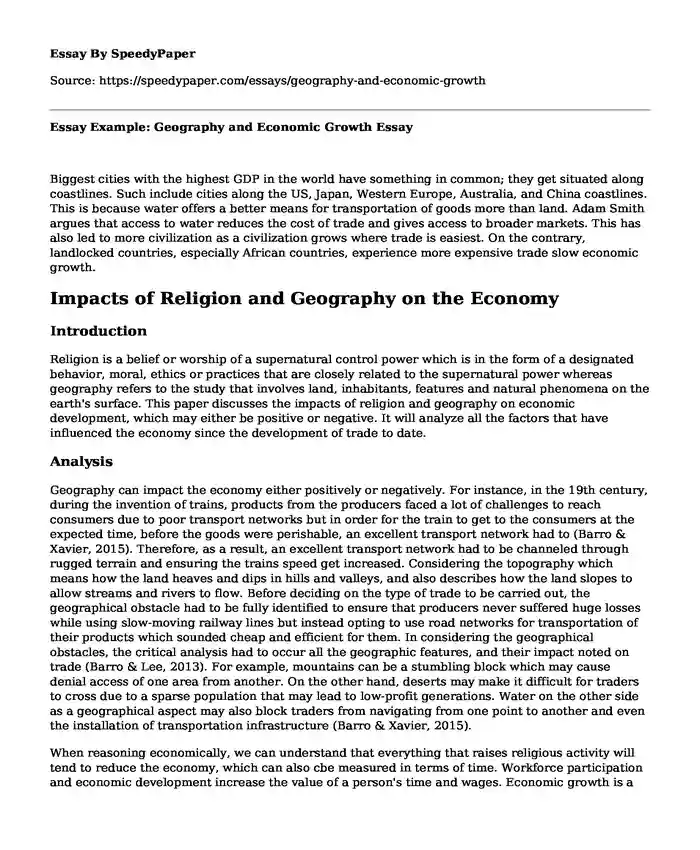
| Type of paper: | Literature review |
| Categories: | Marketing Geography World International business |
| Pages: | 3 |
| Wordcount: | 701 words |
Biggest cities with the highest GDP in the world have something in common; they get situated along coastlines. Such include cities along the US, Japan, Western Europe, Australia, and China coastlines. This is because water offers a better means for transportation of goods more than land. Adam Smith argues that access to water reduces the cost of trade and gives access to broader markets. This has also led to more civilization as a civilization grows where trade is easiest. On the contrary, landlocked countries, especially African countries, experience more expensive trade slow economic growth.
Impacts of Religion and Geography on the Economy
Introduction
Religion is a belief or worship of a supernatural control power which is in the form of a designated behavior, moral, ethics or practices that are closely related to the supernatural power whereas geography refers to the study that involves land, inhabitants, features and natural phenomena on the earth's surface. This paper discusses the impacts of religion and geography on economic development, which may either be positive or negative. It will analyze all the factors that have influenced the economy since the development of trade to date.
Analysis
Geography can impact the economy either positively or negatively. For instance, in the 19th century, during the invention of trains, products from the producers faced a lot of challenges to reach consumers due to poor transport networks but in order for the train to get to the consumers at the expected time, before the goods were perishable, an excellent transport network had to (Barro & Xavier, 2015). Therefore, as a result, an excellent transport network had to be channeled through rugged terrain and ensuring the trains speed get increased. Considering the topography which means how the land heaves and dips in hills and valleys, and also describes how the land slopes to allow streams and rivers to flow. Before deciding on the type of trade to be carried out, the geographical obstacle had to be fully identified to ensure that producers never suffered huge losses while using slow-moving railway lines but instead opting to use road networks for transportation of their products which sounded cheap and efficient for them. In considering the geographical obstacles, the critical analysis had to occur all the geographic features, and their impact noted on trade (Barro & Lee, 2013). For example, mountains can be a stumbling block which may cause denial access of one area from another. On the other hand, deserts may make it difficult for traders to cross due to a sparse population that may lead to low-profit generations. Water on the other side as a geographical aspect may also block traders from navigating from one point to another and even the installation of transportation infrastructure (Barro & Xavier, 2015).
When reasoning economically, we can understand that everything that raises religious activity will tend to reduce the economy, which can also cbe measured in terms of time. Workforce participation and economic development increase the value of a person's time and wages. Economic growth is a determinant of the rising opportunity cost of participating in time investing activities but when engaged more in religious services and prayers, more time will be spent on the unseen effort which tends to be loss of time which as a result leads to low economic development. For a country's gross domestic product to increase, the anticipation always is to see a decrease in regular religious activity. cThis insinuates that only the older and young people with the unlimited value of time are only required to participate in religious activities (Barro & Xavier, 2015). Thus, we can conclude that the more religious a nation is, the more economically crippled they are.
Conclusion
In conclusion, the geographical aspect has a more significant impact on the economy since ancient time. oThis g depicted by factors such as landforms, locations, climate, and transport. These factors though natural, they have a more significant impact that can adversely affect the economy either positively or negatively. On the other hand, religion has significantly impacted the economy. The higher the number of believers attending religious places, the lower the economy. Thus, these two factors, geography, and religion have an impact that can get felt in the economy of a country.
Cite this page
Essay Example: Geography and Economic Growth. (2023, Jan 20). Retrieved from https://speedypaper.com/essays/geography-and-economic-growth
Request Removal
If you are the original author of this essay and no longer wish to have it published on the SpeedyPaper website, please click below to request its removal:
- The Social Media Essay Sample
- The Development of the Human and Technology. Essay Sample.
- Essay Sample: Male Machismo in the Film La Mission
- Annotated Bibliography Example on Sociological Issues
- Coca-Cola Company Employees Motivation - HRM Essay Sample
- Free Essay on How Real-Life Experiences of Emily Dickinson Influenced Her Writing
- Free Essay: Description of Vroom's Model of Expectancy Theory
Popular categories




